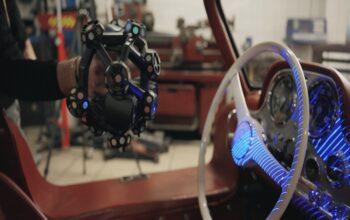A custom production metrology system installed at Safran Reosc in Poitiers allows precision telescope mirror segment evaluation.
The Extremely Large Telescope (ELT) is one of the world’s most ambitious scientific projects. It will have a primary mirror with a diameter of 39 metres, consisting of 798 uniquely shaped hexagonal mirror segments, each with a diameter of approximately 1.5 metres. It has been planned by the European Southern Observatory (ESO), whose headquarters are in Munich, Germany, and is under construction in Chile on the Cerro Armazones at an altitude of 3046 metres. “First light” is planned for 2027.
The contract to manufacture the mirror segments for the main mirror was tendered by ESO and awarded to Safran Reosc in France, a worldwide leader in telescope optics manufacturing. Safran built a dedicated factory in Poitiers, France, to produce a total of 931 mirror segments (including 133 spare mirrors).
For the form measurement in production, Safran Reosc approached Hexagon for the development of a dedicated production metrology system. The aim is to determine the form and curvature of the mirror segments with an array of optical sensors with an uncertainty U (99%) < 20 nm (the thickness of a human hair is around 50 000 nm) in one measurement in production.
Based on Hexagon’s unique Absolute Multiline Technology, which has a proven track record in scientific and industrial implementations, a specialised measurement system was developed for this specific application.
Safran Reosc proposed a design with 19 sensors oriented toward the optical surface and distributed over the surface of the part. The sensors are zeroed on a reference surface that can either be spherical or flat. The sensors measure a distance to the surface under test that is used to compute the absolute form error (including curvature).
The challenge is to ensure the accuracy of the sensors to the desired degree even when measuring an uncoated, partially reflective surface. Furthermore, due to the curvature of the mirrors, the sensors need to measure on surfaces with varying orientations. Based on multiple optical simulations, Hexagon developed a unique sensor design, which was scrutinised by an external institution.
It turned out that finding an independent laboratory to verify the required sensor performance was a challenge on its own; only the Institute for Production Metrology at the University of Erlangen could provide both the equipment and know-how for the task. A team of Hexagon and Safran R&D engineers supported and witnessed the experiments, which ultimately proved the sensor specification over the entire measurement range and on varying surface orientations.
Today the system is in operation at the Safran Reosc facility to produce the mirror segments for the ELT, assuring the form quality of the mirror segments before they are delivered to the ESO.
“The Hexagon Absolute Multiline System enables an independent and accurate form measurement of our mirrors,” explains Dr Camille Frapolli, ELT M1 Chief Engineer at Safran. “We appreciated the flexibility, transparency and technical expertise of the Hexagon team, which allowed us to achieve state-of-the-art performance in absolute length measurement on a nanometre scale. The form and curvature measurements performed using the Hexagon system play a key role in enabling the serial manufacturing of large mirrors.”
The form and curvature measurements performed using the Hexagon system play a key role in enabling the serial manufacturing of large mirrors. Hexagon is proud that its technology has been able to contribute to this amazing project and help mankind to sharpen its view on the universe.











